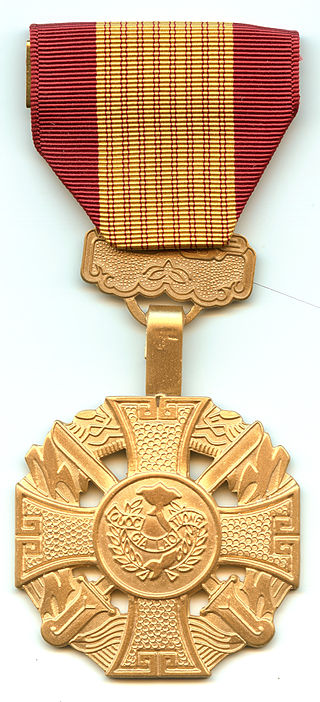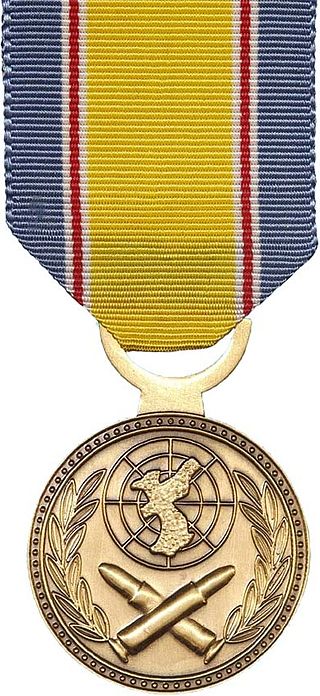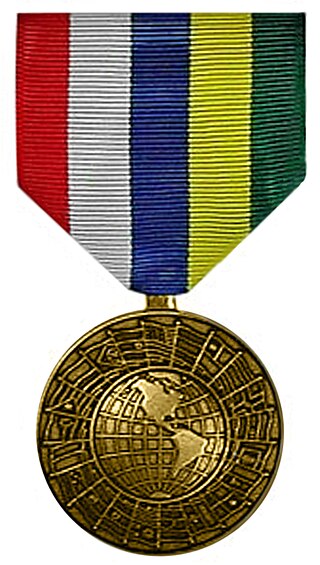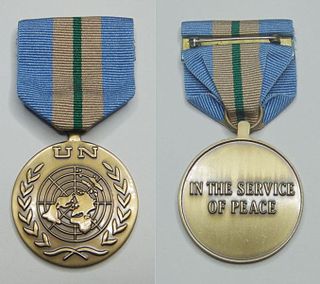
The Legion of Merit (LOM) is a military award of the United States Armed Forces that is given for exceptionally meritorious conduct in the performance of outstanding services and achievements. The decoration is issued to members of the eight uniformed services of the United States as well as to military and political figures of foreign governments.
The Commendation Medal is a mid-level United States military decoration presented for sustained acts of heroism or meritorious service. Each branch of the United States Armed Forces issues its own version of the Commendation Medal, with a fifth version existing for acts of joint military service performed under the Department of Defense.

The Republic of Vietnam Gallantry Cross also known as the Vietnamese Gallantry Cross or Vietnam Cross of Gallantry is a military decoration of the former Government of South Vietnam. The medal was created on August 15, 1950, and was awarded to military personnel, civilians, and Armed Forces units and organizations in recognition of deeds of valor or heroic conduct while in combat with the enemy.

The Joint Meritorious Unit Award (JMUA) is a US military award that was established on June 4, 1981, by Secretary of Defense Caspar Weinberger and was implemented by Department of Defense Directive 1348.27 dated July 22, 1982. The Joint Meritorious Unit Award was made retroactive to January 23, 1979.

The Defense Meritorious Service Medal (DMSM) is an award bestowed upon members of the United States military by the United States Department of Defense. In the order of precedence of the United States Armed Forces, it is worn between the Purple Heart and the Meritorious Service Medal. The medal is awarded in the name of the Secretary of Defense to members of the Armed Forces who, while serving in a joint activity, distinguish themselves by non-combat outstanding achievement or meritorious service, but not of a degree to warrant award of the Defense Superior Service Medal.

The Superior Unit Award is a decoration of the United States Army which is awarded in peacetime to any unit of the Army which displays outstanding meritorious performance of a difficult and challenging mission carried out under extraordinary circumstances.
The Air and Space Outstanding Unit Award (ASOUA) is one of the unit awards of the United States Air Force and United States Space Force. It was established in 1954 as the Air Force Outstanding Unit Award and was the first independent Air Force decoration created. The Air Force Longevity Service Award would follow in 1957 with most of the standard Air Force awards established in the early to mid 1960s.
The Kosovo Campaign Medal (KCM) is a military award of the United States Armed Forces established by Executive Order 13154 of President Bill Clinton on May 3, 2000. The medal recognizes military service performed in Kosovo from March 24, 1999 through December 31, 2013.

The Korean War Service Medal, also known as the Republic of Korea War Service Medal (ROKWSM), is a military award of South Korea which was first authorized in December 1950.

The Meritorious Service Medal (MSM) is a military award presented to members of the United States Armed Forces who distinguish themselves with outstanding meritorious achievement or service to the United States.

The Inter-American Defense Board Medal is an international military award which was created on December 11, 1945, by the 91st session of the Inter-American Defense Board, a Pan-American defense group devoted to the security of the member countries of the Organization of American States.

The Republic of Vietnam Civil Actions Medal also known as the Vietnam Civil Actions Medal or Civil Actions Medal, is a military decoration of the former South Vietnamese government (1955–75). The medal was created on May 12, 1964 during the Vietnam War. The Civil Actions Medal was awarded to the South Vietnamese military and its allies' military personnel or units that performed outstanding achievements in the field of civil affairs. The medal was awarded in two classes, with the first-class intended for commissioned officers and the second class for enlisted personnel. Individuals who were cited received the medal, ribbon, and a citation.

A United Nations Medal is an international decoration awarded by the United Nations (UN) to the various world countries members for participation in joint international military and police operations such as peacekeeping, humanitarian efforts, and disaster relief. The medal is ranked in militaries and police forces as a service medal. The United Nations awarded its first medal during the Korean War (1950–1953). Since 1955, many additional United Nations medals have been created and awarded for participation in various United Nations missions and actions around the world.
An international decoration is a military award which is not bestowed by a particular country, but rather by an international organization such as the United Nations or NATO. Such awards are normally issued as service medals, for participation in various international military operations, and not for specific acts of heroism or bravery.
The NATO Medal is an international military decoration which is awarded to various militaries of the world under the authority of the North Atlantic Treaty Organization (NATO). It is manufactured by Eekelers-Centini Intl, of Hemiksem, Belgium.

This is a list of Norwegian orders and medals, in order of precedence. This list contains all medals approved for wearing on a Norwegian military uniform in ranked order.

The Sri Lankan Armed Forces award medals and their associated ribbon bars in recognition of various levels of service, personal accomplishments and commemorative events while a regular- or volunteer serviceperson is a member of the Sri Lanka Army, Sri Lanka Navy and the Sri Lanka Air Force. Together with military badges, such awards are a means to outwardly display the highlights of a serviceperson's career.

The Awards and decorations of the German Armed Forces are decorations awarded by the German Bundeswehr, the German government, and other organizations to the German military and allied forces. Modern era German military awards have been presented since the establishment of the Federal Republic of Germany in 1949.
 United Nations Truce Supervision Organization (UNTSO) in Palestinian territories/United Nations Observation Group in Lebanon
United Nations Truce Supervision Organization (UNTSO) in Palestinian territories/United Nations Observation Group in Lebanon United Nations Observer Group in India and Pakistan
United Nations Observer Group in India and Pakistan  United Nations Korea Medal
United Nations Korea Medal  United Nations Temporary Executive Authority/UN Security Force in West New Guinea
United Nations Temporary Executive Authority/UN Security Force in West New Guinea  United Nations Iraq–Kuwait Observation Mission
United Nations Iraq–Kuwait Observation Mission  United Nations Mission for the Referendum in Western Sahara
United Nations Mission for the Referendum in Western Sahara  United Nations Advance Mission in Cambodia
United Nations Advance Mission in Cambodia United Nations Protection Force in Yugoslavia
United Nations Protection Force in Yugoslavia  United Nations Transitional Authority in Cambodia
United Nations Transitional Authority in Cambodia  United Nations Operation in Somalia II
United Nations Operation in Somalia II  United Nations Operation in Mozambique
United Nations Operation in Mozambique  United Nations Observer Mission in Georgia
United Nations Observer Mission in Georgia  United Nations Mission in Haiti/United Nations Support Mission in Haiti
United Nations Mission in Haiti/United Nations Support Mission in Haiti  United Nations Preventive Deployment Force
United Nations Preventive Deployment Force  United Nations Transitional Administration for Eastern Slavonia, Baranja and Western Sirmium
United Nations Transitional Administration for Eastern Slavonia, Baranja and Western Sirmium  United Nations Verification Mission in Guatemala
United Nations Verification Mission in Guatemala  United Nations Special Service Medal/United Nations Assistance Mission in Iraq
United Nations Special Service Medal/United Nations Assistance Mission in Iraq  United Nations Interim Administration Mission in Kosovo
United Nations Interim Administration Mission in Kosovo  United Nations Mission in East Timor/United Nations Transitional Administration in East Timor/United Nations Mission of Support to East Timor
United Nations Mission in East Timor/United Nations Transitional Administration in East Timor/United Nations Mission of Support to East Timor  United Nations Mission in the Democratic Republic of Congo/United Nations Organization Stabilization Mission in the Democratic Republic of the Congo
United Nations Mission in the Democratic Republic of Congo/United Nations Organization Stabilization Mission in the Democratic Republic of the Congo  United Nations Mission in Ethiopia and Eritrea
United Nations Mission in Ethiopia and Eritrea  United Nations Mission in Liberia
United Nations Mission in Liberia  United Nations Stabilisation Mission in Haiti
United Nations Stabilisation Mission in Haiti  United Nations–African Union Mission in Darfur
United Nations–African Union Mission in Darfur  United Nations Mission in the Central African Republic and Chad
United Nations Mission in the Central African Republic and Chad  United Nations Organization Stabilization Mission in the Democratic Republic of the Congo
United Nations Organization Stabilization Mission in the Democratic Republic of the Congo  United Nations Multidimensional Integrated Stabilization Mission in the Central African Republic
United Nations Multidimensional Integrated Stabilization Mission in the Central African Republic  United Nations Multidimensional Integrated Stabilization Mission in Mali
United Nations Multidimensional Integrated Stabilization Mission in Mali 











